The Walt Disney Company, every child’s dreamland while growing up (and also for some of us as adults), is one of the biggest franchises in the entire world. It has a long and rich history and has gone through many changes over the past many decades that it has operated. Does Disney even need an introduction?
Disney is an American multinational media conglomerate that has its headquarters in California. Formally, the company was established a century ago in 1923 and has gone through many name changes before settling on the current one.
The magic of Disney is not something that can be captured in a few lines. Disney itself could make a whole production out of the journey it has been through since its inception. Walt Disney started the Disney Brothers’ Cartoon Studio with his brother Roy Disney after Walt’s previous studio had gone bankrupt. Their first hit was a character that is still widely beloved today, the iconic Mickey Mouse.
Then they moved towards producing many other films and series. The company went through many changes in leadership and expansions to reach the place it is at today. In 2023, they had 191,250 employees, and their revenue in the year 2023 was $88.935B, a 5.35% increase year-over-year.
On the surface level, Disney might seem like a company that has it all set out for itself. It is the perfect big name in the industry. However, on deeper analysis, one can notice some tensions here and there that might be a cause for trouble. To evaluate these things properly and sum up how things look like for Disney right now, we will look at this Disney SWOT Analysis.
Incorporating SWOT into their business plans allows a giant like Disney to stay ahead of the curve, innovate continuously, and maintain their leading position in the entertainment industry. It’s like having a map and compass in the world of business—guiding you through decisions and helping navigate challenges!
Disney Strengths
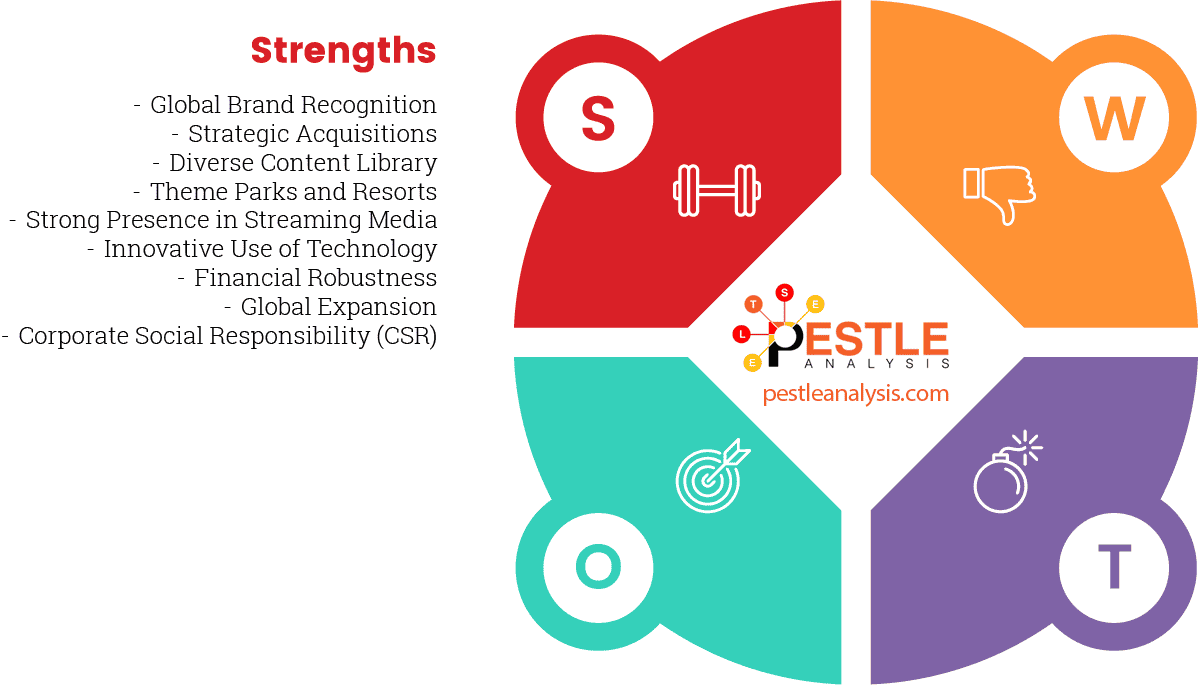
Writing a SWOT analysis for Disney begins by focusing on its strengths. These involve a variety of factors, including its brand legacy, diverse entertainment portfolio, technological innovations, and strategic business moves. Here’s a detailed look at Disney's strengths:
- Global Brand Recognition: Disney has been around for a hundred years, and they have tried it all. They have had enough time to experiment within the market and see what does and what does not work for their customers. This sort of market experience can definitely come in handy. Being around for so many years also establishes you as a trustworthy and well-known name amongst the masses. It is a brand that everyone recognizes and loves. Disney has been on the list of top ten companies by Fortune many times. It has a compelling brand image. Their logo is instantly recognizable by anyone, and their mergers have only made them more powerful. Reports have shown Disney products to be highly popular within the consumer base. They own many popular and widely known characters, characters that many of us have grown up with and idolized during our childhood. They have some of the best artists and writers in the world. If Disney were to come out with a new character today, people would still rush to see it on the screen because that is the power that they hold. Disney has made itself into a brand that no one can think of replacing.
- Strategic Acquisitions: Disney’s strategy of acquiring other companies has helped it maintain a competitive edge and diversify its portfolio. The acquisitions of Pixar, Marvel, Lucasfilm, and 21st Century Fox have all been transformative, contributing to Disney’s growth and dominance in the entertainment industry.
- Diverse Content Library: With the acquisition of 21st Century Fox, Disney has significantly expanded its content library. It now owns a vast array of media and entertainment franchises, such as Marvel, Star Wars, Pixar, and National Geographic, which are critical assets that drive significant revenue streams, giving them a robust presence in the market. The brand has diversified itself a lot over time and is currently known for many things: its film studio, television shows, streaming service, games, merchandise, and theme parks. All of these are pretty huge names on their own, so one can only imagine the profit they bring to Disney. By having such a different variety of products in the market, Disney makes itself into a name that you will hear no matter where you go.
- Theme Parks and Resorts: Disney’s theme parks and resorts are among the most visited and profitable in the world. They have a reputation for exceptional customer experience and have been expanding with new attractions and experiences, which helps in maintaining high visitor numbers and profitability.
- Strong Presence in Streaming Media: Disney’s streaming services, such as Disney+, Hulu, and ESPN+, have seen tremendous growth. Disney+ has rapidly gained subscribers since its launch, benefiting from its strong brand and exclusive content offerings.
- Innovative Use of Technology: Disney has been at the forefront of technological integration in entertainment, utilizing virtual reality (VR) and augmented reality (AR) to enhance viewer experiences, both in its parks and through its media content.
- Financial Robustness: Disney consistently shows strong financial performance with robust revenue streams from its diverse business operations, which include television, streaming media, theme parks, and consumer products. This financial stability allows Disney to invest in new projects and innovations. Their income has helped Disney constantly open new projects and turn them into sources of revenue. They have a sturdy cash flow, which keeps things moving and steady for them. The finances of Disney work in a cycle: they get a ton of money from their diversified sources, which in turn helps them invest in more projects to open up more sources of cash inflow. They have mastered the art of financial stability. Their projects have also shown a good return on investment. Disney has a knack for innovation with its ever-increasing range of products. They used their streaming service Disney+ to counter the pandemic. Their revenue from this actually increased at the end of 2020. Such strategies have helped the shareholders find new confidence in the company, something which shows by their current place in the stock market.
- Exceptional Employee Talent: The company’s workforce is as magical as its productions. Disney invests a lot of money into the training of their employees, which makes them some of the most talented ones in the industry. If one steps into Disneyland, one will see how dedicated the employees are to their work. A lot of people dream of working at Disney, which makes them very committed and loyal to their jobs. Their creative workforce is also insanely talented. This is evident from the absolutely stunning productions that Disney is known for. Their writers and designers are indeed one of a kind. They are also some of the most experienced ones in the media industry.
- Global Expansion: Disney has made significant strides in expanding its market by tailoring its offerings to local tastes and cultures, particularly in major markets like China and India. This global strategy not only broadens its audience but also mitigates the risk of over-dependence on the North American market.
- Corporate Social Responsibility (CSR): Disney’s commitment to environmental sustainability, diversity, and community engagement enhances its corporate image and appeal to socially conscious consumers. The company has shown its commitment to providing a safe experience for all of its customers. They also have shown concern for many social issues such as human rights and the conservation of water. They have a Nutrition Guideline Policy and Disney Check, which advocates for healthy living. They make their marketing strategies responsible as well because chilwdren view their content.
Disney Weaknesses
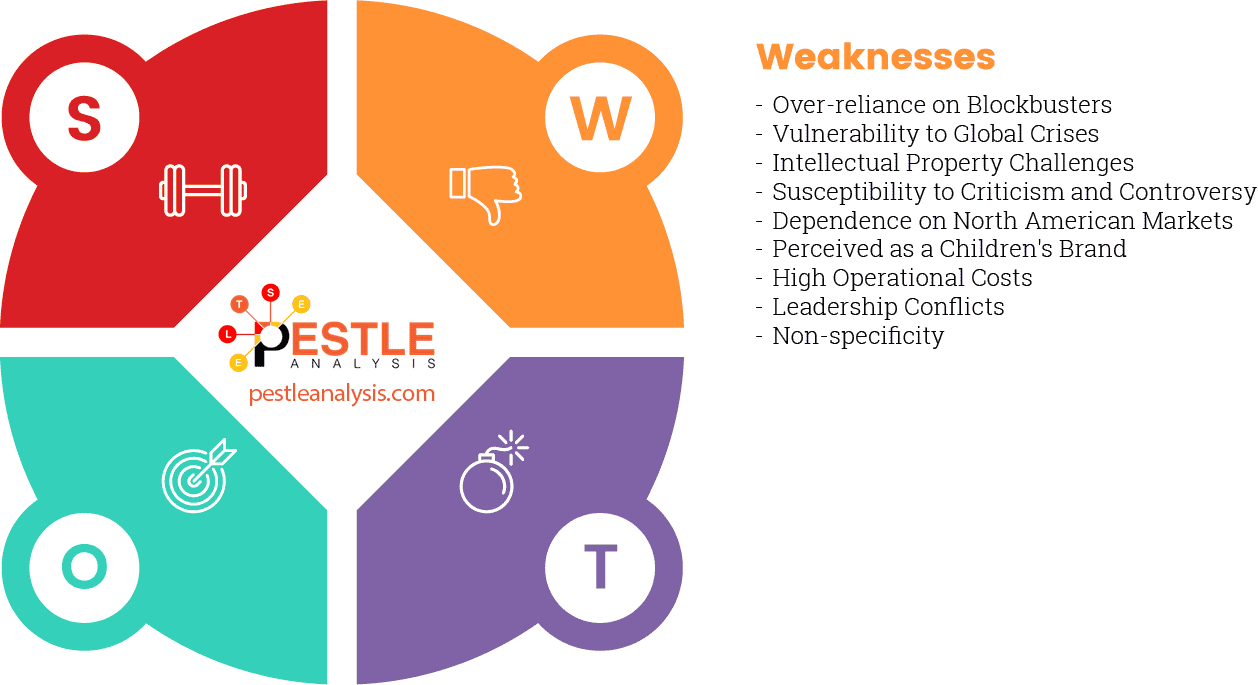
Second in the list of every SWOT analysis come the weaknesses. Identifying the weaknesses of Disney requires an examination of areas where the company may face challenges or limitations that could hinder its performance or growth. Here are some key weaknesses:
- Over-reliance on Blockbusters: Disney's film strategy heavily relies on blockbusters from its major franchises like Marvel, Star Wars, and Pixar. While successful, this approach can be risky; a failure of key releases can significantly impact overall profitability.
- Vulnerability to Global Crises: The COVID-19 pandemic highlighted Disney's vulnerability to global crises, particularly with its heavy reliance on revenue from physical operations like theme parks and resorts. The COVID-19 pandemic led to the loss of a ton of money and some downsizing within the company. All of the theme parks and other physical attractions that Disney has closed down during the pandemic, which was a huge hit on the finances of the company as it drives a good chunk of its money from these spots. They also lost a lot of their workforce due to these closures. This was a reminder for the company to spread its financial dependence over all of its projects equally so that the sudden closure of one does not become too big of a hit for it.
- Intellectual Property Challenges: Managing and protecting extensive intellectual property (IP) is a constant challenge. Infringement risks and the need to continually innovate within existing franchises without alienating fans can be problematic.
- Susceptibility to Criticism and Controversy: When you are a company of this magnitude, there are many chances of being looped into controversies, especially related to media production. Disney was no exception to this. They have been facing criticisms over stereotypical representation of non-white characters, allegations of plagiarism, and other concerns regarding their theme parks. As a big brand, issues like these can really hurt your reputation hence requiring you to be constantly in check of your actions.
- Dependence on North American Markets: Although Disney is expanding globally, it still relies heavily on North American markets for a substantial portion of its revenues. This geographical concentration increases its vulnerability to regional economic or political instability.
- Perceived as a Children's Brand: Despite its broad appeal across various age groups, Disney often battles the perception of being primarily a children's entertainment company. Many think that Disney is a media corporation exclusively producing kids’ content. This is not true as adults have shown enjoyment for Disney’s productions and ventures too; however, the image of being ‘just another Kid’s brand’ might keep a huge segment of consumers away from them. Overcoming this stereotype is crucial for Disney to fully tap into and monetize the adult demographic, ensuring that potential revenue from this segment is not lost.
- High Operational Costs: Operating extensive theme parks and producing high-quality entertainment is costly. Disney's dependence on continuous investment in its parks and media content can strain its finances, especially in times of economic downturn.
- Leadership Conflicts: Reports of internal rifts within Disney's top leadership can pose significant challenges. A situation like this can often blow up and cause devastating impacts that trickle down to different facets of the company. Such conflicts have the potential to disrupt strategic alignment and decision-making processes. If these rifts escalate, they can lead to wider organizational instability, affecting everything from project execution to employee morale. Effective management of leadership dynamics is crucial to prevent these internal conflicts from having a detrimental impact on the company’s overall performance and reputation.
- Non-specificity: We have seen how Disney’s different product ranges have proven to be beneficial for the company. But arguably, they can become a weakness as well. If a brand becomes a jack of all trades, they might have a hard time becoming a master of any. This might be a problem if the brand expands so much that it becomes hard to develop its products correctly. This is definitely a factor that the company needs to focus on while working on a variety of expansions.
- Regulatory Challenges: Disney operates in a highly regulated environment across the globe, which can impact its operations through restrictions and compliance costs. Issues such as antitrust concerns, especially following its major acquisitions, can pose significant hurdles.
Disney Opportunities
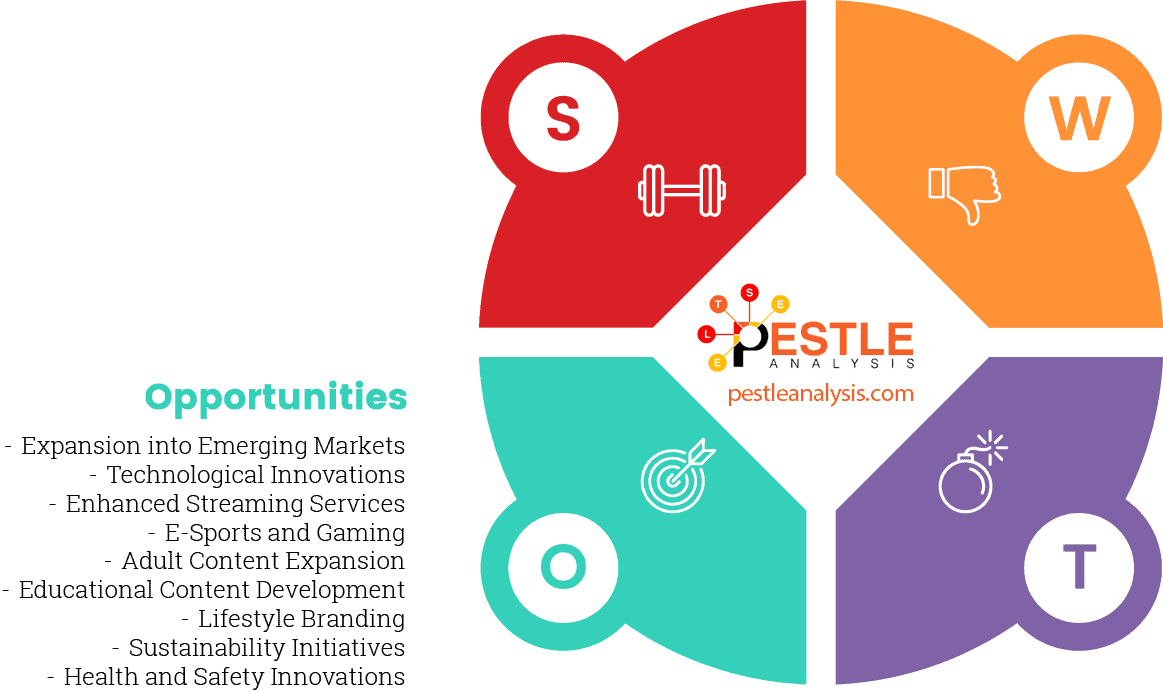
Next up in our Disney SWOT analysis is opportunities. Looking ahead, Disney has several opportunities to leverage for growth and expansion. Here's a comprehensive list of potential opportunities for Disney:
- Expansion into Emerging Markets¨Disney is a globally recognized brand, and this gives them the opportunity to expand their business in other markets. They can choose to open up their physical attractions in many different locations worldwide. Disney can further penetrate emerging markets like Southeast Asia, Africa, and parts of Latin America, where demand for entertainment and digital content is growing rapidly.
- Technological Innovations: They can also start providing this experience to international consumers virtually. The brand has the resources and technology to make this happen, so why not venture out in this direction? Advancements in AR, VR, and AI can offer Disney new ways to enhance interactive experiences both in their theme parks and through digital media platforms, providing more immersive and personalized experiences for users. Advancements in manufacturing technologies like 3D printing offer Disney an opportunity to offer customizable and interactive merchandise, enhancing consumer engagement and satisfaction.
- Enhanced Streaming Services: There's an opportunity to expand Disney+ and other streaming platforms with more diverse content offerings that cater to different regional tastes and preferences. This includes local language content and region-specific programming. Streaming services are becoming increasingly popular, and there is a lot of room to play with here. Disney can use the different characters it holds, like those from popular names like Marvel, to develop more titles for Disney+.
- Example: The DirecTV-Disney dispute in 2024, which caused a blackout of Disney channels, pushed many viewers to switch to streaming alternatives like YouTube TV. This event highlights the potential for Disney to strengthen and expand its streaming services to capture this shifting audience.
- E-Sports and Gaming: Entering the gaming industry and e-sports could diversify Disney’s entertainment offerings and tap into a fast-growing sector that engages millions of young and adult gamers globally. They have a wide range of characters to make for exciting gameplay and establish more of a position in the video game industry to meet the rising demand.
- Adult Content Expansion: Expanding the range of content aimed at adults, particularly through platforms like Hulu and the Star brand internationally, could attract a broader audience and dispel the notion of Disney as just a 'kid’s' brand.
- Educational Content Development: With the rise of digital learning, Disney could develop educational content and platforms that leverage its storytelling expertise to educate children and young adults.
- Lifestyle Branding: Disney can expand its branding into other lifestyle sectors such as themed hotels, cruises, dining experiences, and even wellness retreats that offer Disney-themed experiences beyond traditional media and entertainment.
- Sustainability Initiatives: As global awareness of environmental issues grows, Disney has the opportunity to lead in sustainability within the entertainment industry. This could involve eco-friendly theme parks, sustainable merchandising practices, or green media production techniques.
- Health and Safety Innovations: Post-pandemic, there's an ongoing opportunity to innovate in health and safety protocols for physical venues to reassure and attract visitors, ensuring Disney’s theme parks and resorts remain top destinations.
Disney Threats
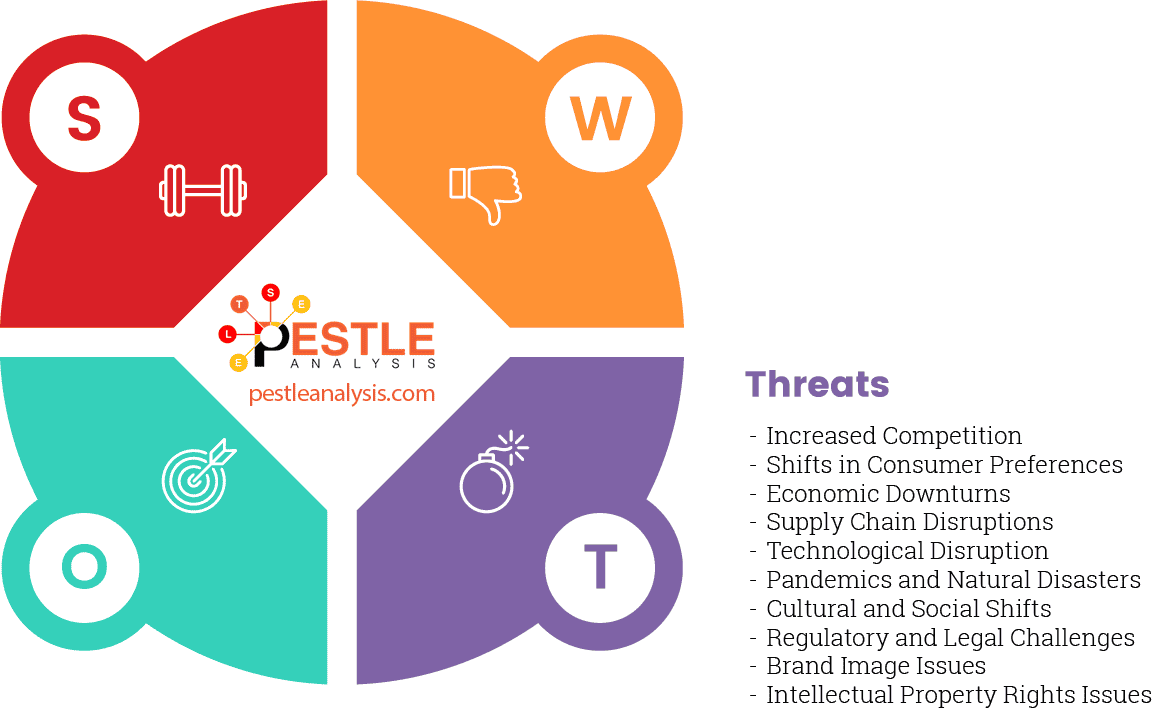
As we reached the final section of our SWOT analysis, Disney must also be aware of potential threats that could impact its business operations and growth. Here are several key threats to consider:
- Increased Competition: The entertainment and media landscapes are increasingly crowded, with competitors like Netflix, Amazon Prime Video, and emerging platforms intensifying the competition, particularly in the streaming space. Disney has had a trend of acquiring most of its competition in the market. Despite this, they still have some significant competitors left to deal with, for example, CBS, Sony, Six Flags Entertainment, etc. Any competitor that provides quality entertainment for lower prices is especially a big threat. Different companies are coming up with new technologies as well as cheaper products that can give Disney a run for its money. Competition is a threat that can substantially affect even the very biggest of names, and Disney is not immune to that. The company needs to come up with strategies to effectively keep this competition from damaging its position in the market.
- Shifts in Consumer Preferences: The preferences of media consumers are constantly evolving, and a shift away from Disney’s traditional media formats or content styles could impact its viewership and profitability.
- Economic Downturns: Global or regional economic instability, such as recessions, can reduce consumer spending on entertainment and leisure, affecting Disney’s revenues from its parks, movies, and merchandise. There are some specific financial threats that every multinational corporation is exposed to. Currency fluctuations, inflation in the prices of raw materials, and disturbances in the supply chain are only some, to begin with. Most of these problems come up suddenly and unexpectedly. Hence, these are all threats that a company needs to be effectively prepared for well before in time, so they can be tackled once they come up.
- Supply Chain Disruptions: Global supply chain issues, whether due to political unrest, trade disputes, or natural disasters, can affect the availability and cost of merchandise and even the construction of new attractions or facilities.
- Technological Disruption: Rapid changes in technology could render some of Disney’s current offerings obsolete or require significant investment to stay current, especially in digital media and content distribution.
- Pandemics and Natural Disasters: As seen with COVID-19, pandemics or major natural disasters can significantly disrupt operations, particularly in physical experiences like theme parks and cruise lines.
- Cultural and Social Shifts: Changing demographics and social attitudes can affect the popularity of Disney’s traditional content. There is also the risk of backlash if Disney does not handle sensitive topics appropriately in its global markets.
- Regulatory and Legal Challenges: Increased scrutiny from regulators, especially concerning antitrust issues, privacy concerns, and use of consumer data, could lead to restrictions, fines, or forced changes in how Disney operates.
- Brand Image Issues: Controversies or negative publicity, such as those arising from operational mishaps, employee relations, or insensitive content, can damage Disney’s family-friendly brand.
- Intellectual Property Rights Issues: Piracy and intellectual property theft remain significant threats, especially in international markets, potentially eroding profits and the value of Disney’s content. Pirated content is available to people very easily through the cheapest of means, often even free. It is also becoming increasingly harder to put restrictions on piracy. This becomes a threat for media companies because their legally acquired content costs more than the pirated content, and hence, people tend to move towards purchasing pirated copies.
- Cybersecurity Threats: As Disney continues to expand its digital platforms, it becomes more susceptible to cybersecurity risks, which could compromise customer data and trust.
Recommendations based on our Disney SWOT Analysis
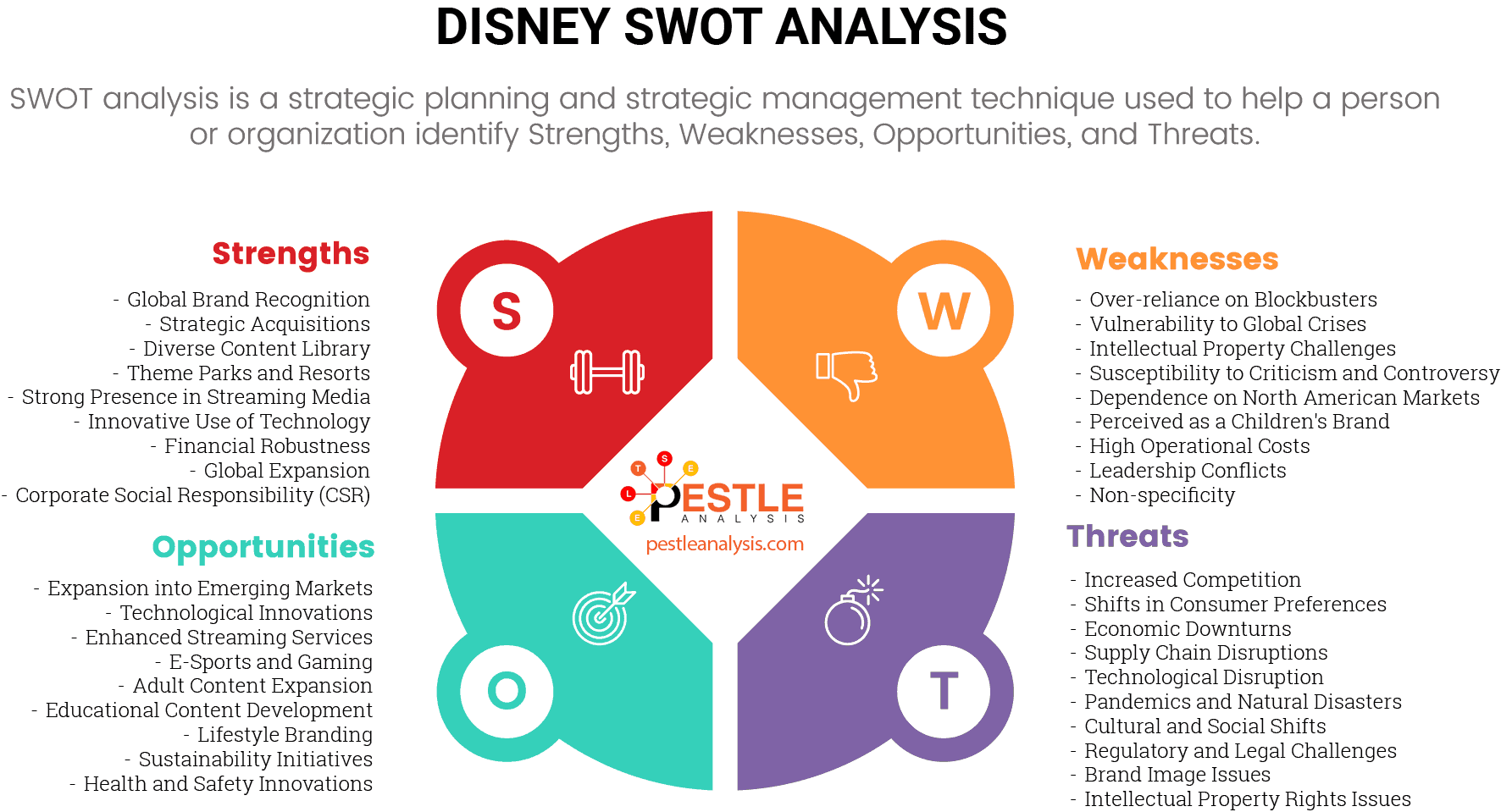
A comprehensive look at Disney through a SWOT analysis gives us a lot of insight into its operations. Disney is still one of the strongest brands in the world, and that does not seem like it will change, despite any hurdles they might face.
If Disney has certain threats and weaknesses, they also have the resources to overcome them adequately. If they make the correct use of their strengths, the magic is here to stay forever.
After completing our SWOT analysis of Disney, don't miss our PEST analysis of Disney to get an even fuller picture of the external factors impacting it. It delves deeper into the Political, Economic, Social, and Technological factors that shape Disney’s business environment.
For those interested in understanding how Disney stacks up against its competition, check out the analysis of major Disney competitors below. There, you’ll find detailed comparisons and insights into how Disney and its competitors navigate the complex landscape of the entertainment industry. Explore these resources to gain a broader understanding of what drives success in this dynamic sector.







